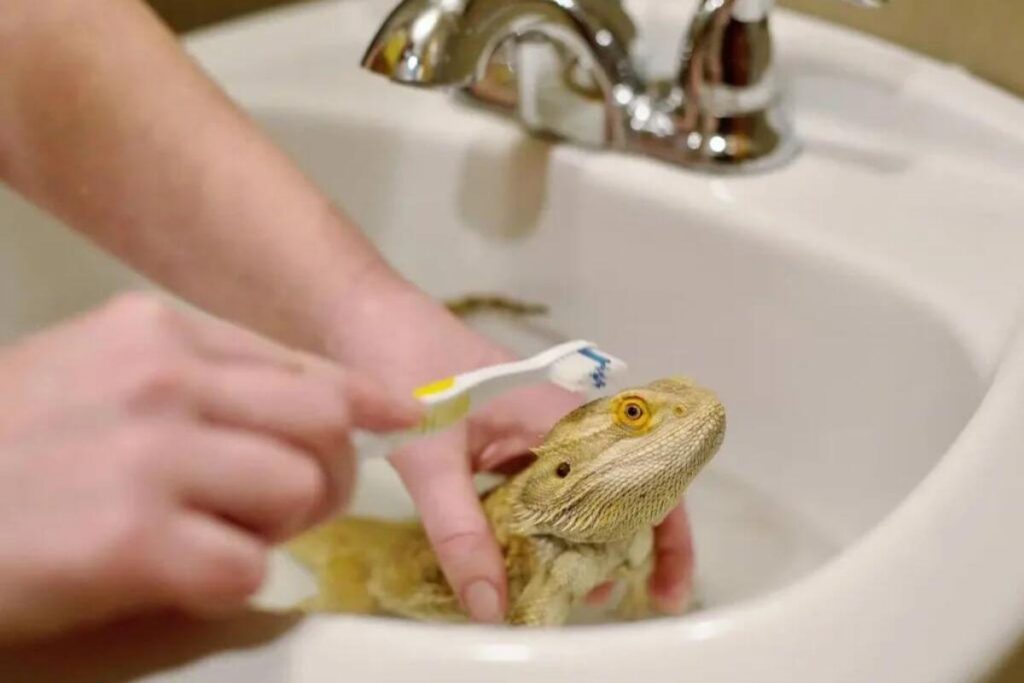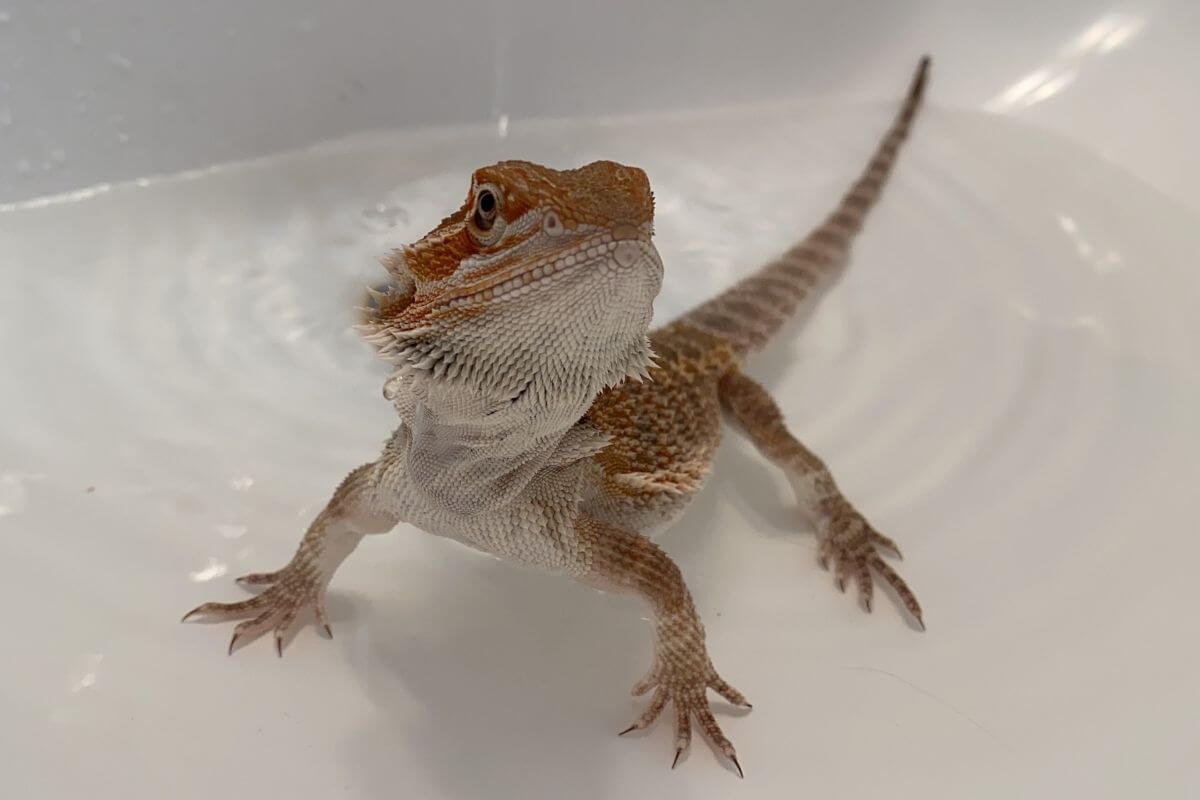Bearded dragons, known for their unique appearance and amiable nature, are fascinating reptile pets. These creatures require specific care and maintenance to ensure they thrive in captivity. Among the aspects of their care, regular bathing is a critical component of keeping your bearded dragon healthy and happy. But what happens if you neglect this aspect of their care? In this comprehensive guide, we’ll explore the importance of bathing for bearded dragons and the potential consequences of not providing them with this essential care.
Why Do Bearded Dragons Need Baths?
Bearded dragons originate from arid regions of Australia, where they encounter a dry and sunny climate. In captivity, it’s crucial to replicate these conditions to maintain their overall well-being. Bathing serves several important purposes for these reptiles:
1. Hydration:
Bearded dragons often struggle to drink water from a dish. By allowing them to soak in shallow water, they can absorb moisture through their skin and even drink some water during the bath. Adequate hydration is vital for their health.
2. Shedding:
Bearded dragons shed their skin periodically, much like snakes. A bath helps soften and loosen the old skin, making it easier for them to shed without complications. Incomplete shedding can lead to discomfort and even health issues.
3. Waste Elimination:
Bearded dragons often defecate in their enclosure, and their droppings can sometimes stick to their vent or tail. A bath helps soften and remove this waste, preventing infections or complications.
4. Temperature Regulation:
Bathing your bearded dragon provides a controlled environment for them to regulate their body temperature. They can cool down or warm up during the bath, which is essential for their overall comfort.
Consequences of Not Bathing Your Bearded Dragon
Now, let’s delve into what can happen if you neglect to bathe your bearded dragon:
1. Dehydration:
Without regular baths, your bearded dragon may become dehydrated. Inadequate hydration can lead to a range of health issues, including kidney problems, digestive difficulties, and overall discomfort.
2. Shedding Problems:
Failure to assist your bearded dragon in shedding can result in retained shed, a condition where pieces of old skin don’t come off entirely. This can lead to constrictions, circulation issues, and even infection.
3. Impaction:
Bearded dragons can sometimes ingest substrate or foreign objects accidentally. A lack of baths can contribute to impaction, where undigested material accumulates in their digestive system, potentially leading to blockages.
4. Skin Infections:
The accumulation of dirt and waste on their skin, especially around the vent area, can create a breeding ground for bacteria. This can result in skin infections that cause discomfort and require veterinary care.
5. Temperature Stress:
Bearded dragons need a temperature gradient in their habitat. Without the opportunity to regulate their temperature in a bath, they may become too hot or too cold, causing stress and potential health issues.
6. Behavioral Issues:
Lack of interaction and environmental enrichment during baths can lead to behavioral problems. Bearded dragons may become stressed or agitated, affecting their overall temperament.
How to Bathe Your Bearded Dragon
To ensure the well-being of your bearded dragon, it’s essential to establish a regular bathing routine. Here’s how to do it:
Prepare the Bath:
Fill a shallow container with lukewarm water. The water level should be approximately up to their elbows, allowing them to sit comfortably.
Gently Place Your Dragon in the Bath:
Hold your bearded dragon and place them in the water. Be sure to support their body and avoid sudden movements.
Supervise the Bath:
Never leave your bearded dragon unattended during a bath. They should be within your sight at all times.
Allow Soaking Time:
Let your bearded dragon soak for about 10-20 minutes. This gives them time to hydrate, regulate their temperature, and soften their skin for shedding.
Gentle Cleaning:
If necessary, you can gently use a soft toothbrush to help remove any stuck shed or waste around their vent area.

Dry Thoroughly:
After the bath, pat your bearded dragon dry with a soft towel to prevent them from getting too cold.
Return to Their Habitat:
Place your dragon back in their enclosure with access to fresh water for drinking.
Conclusion
Bathing your bearded dragon is not just a luxury; it’s a vital aspect of their care. Regular baths help keep them hydrated, aid in shedding, prevent health issues, and provide environmental enrichment. Neglecting to bathe your bearded dragon can result in dehydration, shedding problems, impaction, skin infections, temperature stress, and behavioral issues.
Make bathing a part of your routine care, and ensure that the experience is stress-free and comfortable for your pet. By providing your bearded dragon with the care they need, you’ll enjoy a healthier, happier, and more vibrant reptilian companion.
Tips for Successful Bearded Dragon Bathing
Bathing your bearded dragon should be a positive experience for both you and your pet. Here are some tips for successful bearded dragon bathing:
Consistency:
Establish a regular bathing schedule for your bearded dragon. This routine helps them get used to the process and ensures they receive the benefits of bathing consistently.
Water Temperature:
The water should be lukewarm, around 95-100°F (35-38°C). Use a thermometer to monitor the water temperature and avoid hot or cold extremes.
Use a Safe Container:
Choose a shallow container that allows your bearded dragon to sit comfortably with their head above the water. A plastic storage bin or a specialized reptile bath can work well.
Supervision:
Never leave your bearded dragon unattended during a bath. They can be active, and safety is paramount.
Gentle Handling:
Handle your bearded dragon gently when placing them in the bath and removing them. Support their body and avoid sudden movements to minimize stress.
Hydration and Soaking Time:
Bearded dragons can both drink and soak during their bath. Let them soak for 10-20 minutes, allowing for hydration and the softening of skin for shedding.
Assist Shedding:
If your bearded dragon is having trouble shedding, you can gently use a soft toothbrush or your fingers to help remove loose shed. Be cautious not to pull on attached skin.
Clean the Bathing Container:
Ensure that the bathing container is clean and free of any chemicals or residues that could harm your pet.
Pat Dry:
After the bath, pat your bearded dragon dry with a soft towel. Make sure they are dry before returning them to their habitat to prevent temperature stress.
Positive Reinforcement:
Offer treats or positive reinforcement during and after the bath to create a positive association with the experience.
Seeking Professional Help
If you encounter any health issues or unusual behaviors in your bearded dragon, it’s essential to seek professional veterinary assistance. Bearded dragons are prone to various health conditions, and early intervention can make a significant difference in their well-being.
In conclusion, bathing your bearded dragon is not an optional task but an essential part of their care. Regular baths provide hydration, help with shedding, prevent health problems, and offer enrichment. Neglecting this aspect of care can lead to a range of issues that can affect your pet’s health and well-being. With proper bathing techniques and a consistent routine, you can ensure that your bearded dragon remains healthy, happy, and comfortable in their captivity.
Certainly, here are some frequently asked questions (FAQs) related to bathing your bearded dragon:
FAQS
1. How often should I bathe my bearded dragon?
The frequency of baths for your bearded dragon can vary based on their age and specific needs. Generally, providing a bath once or twice a week is a good routine for adults. Juveniles and babies may benefit from more frequent baths to aid in hydration and shedding. Adjust the frequency as needed.
2. What should be the water temperature for my bearded dragon’s bath?
The water temperature for your bearded dragon’s bath should be around 95-100°F (35-38°C). Use a thermometer to ensure that the water is within this temperature range. Avoid water that is too hot or too cold, as it can stress your pet.
3. Can I use tap water for my bearded dragon’s bath?
Using tap water is generally safe as long as it’s free of harmful chemicals like chlorine or chloramine. If your tap water contains these chemicals, consider using a water conditioner to make it safe for your pet. Some reptile owners prefer to use dechlorinated water or natural spring water.
4. How long should I let my bearded dragon soak in the bath?
Bearded dragons typically benefit from soaking for 10-20 minutes. This allows them to hydrate, regulate their temperature, and soften their skin for shedding. Keep a watchful eye on your pet during the bath to ensure their safety.
5. Can I use soap or shampoo in my bearded dragon’s bath?
It’s not advisable to use soap, shampoo, or any chemicals in your bearded dragon’s bath. These substances can be harmful to your pet and should be avoided. A plain water bath is sufficient for their needs.
6. How can I help my bearded dragon with shedding during the bath?
If your bearded dragon is having difficulty shedding, you can gently assist by using a soft toothbrush or your fingers. Be cautious not to pull on attached skin, and focus on loosening and removing only the loose shed.
7. What if my bearded dragon refuses to take a bath?
Some bearded dragons may be reluctant to take baths. In such cases, ensure that the water temperature is suitable, provide a comfortable and shallow bath, and use positive reinforcement. Over time, they may become more accustomed to the process.
8. What are the signs that my bearded dragon needs a bath?
Signs that your bearded dragon may need a bath include retained shed, dehydration, difficulty passing waste, or signs of skin infections. Regular baths can prevent these issues, but if you notice any of these signs, it’s time for a bath.
9. What if my bearded dragon is stressed during the bath?
Bearded dragons can get stressed during baths, especially if they are not accustomed to the routine. Ensure a comfortable water temperature, gentle handling, and a safe, shallow container. Offer positive reinforcement and be patient to help them adapt to the process.
10. What should I do if my bearded dragon has health issues related to bathing?
If you suspect that your bearded dragon has health issues related to bathing, such as skin infections or impaction, consult a reptile veterinarian immediately. Early intervention can prevent more severe problems and ensure your pet’s well-being.



